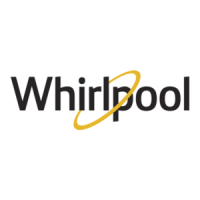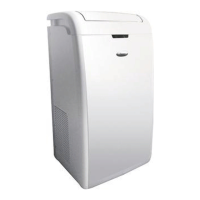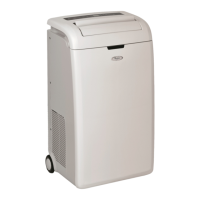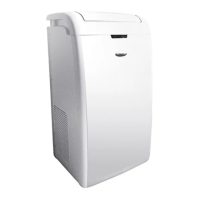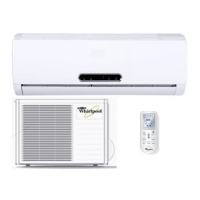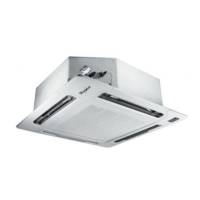25
PRECAUTIONS FOR USE
Warning:
• Make sure to insert the power plug securely.
Insecure insertion of the plug may cause
electrocution or fire.
• Never unplug the machine while running.
• Do not damage the cord or use an unapproved
cord.
• Do not plug other electric appliances into the
same socket or use extension cords.
• Never operate the air conditioner with wet
hands.
• Do not pull the plug out by the cord. This could
cause the cord to overheat and catch fire.
• Turn off the air conditioner and pull out the plug
when cleaning the air conditioner. This will
prevent electrocution or injury.
• The rated voltage of this air conditioner is 220-
240V with a tolerance of ±22V for fluctuation.
The compressor will vibrate if the voltage is too
low, causing damage to the cooling system.
• If you notice anything unusual (e.g. burnt smell),
switch off the power supply immediately and
contact the Whirlpool Authorized Service
Center nearest you.
If the abnormal condition continues, the air
conditioner could be damaged and could also
cause electrocution or fire.
• Grounding: The unit must be reliably grounded.
The grounding cable must be connected to the
special grounding system in the building.
If the building does not have a grounding
system, ask an expert electrician to install one.
Never connect the grounding cable to a gas
pipe, water pipe, sewage pipe or other unless
the professional considers it reliable.
• Make sure to unplug air conditioner when not in
use for an extended period. Accumulation of
dust could cause heating or fire.
• Set the room temperature appropriately. The
difference between indoor and outdoor
temperature should be 5°C.
Appropriate adjustment of the temperature
setting serves to reduce consumption.
• When the air conditioner is running, do not
leave doors and windows open in the room.
This will prevent loss of effectiveness of the air
conditioner.
• Never block the air inlet or outlet of indoor and
outdoor unit, as this will decrease the effect of
the air conditioner or cause it to shut down or
even catch fire.
• Spray cans, chemicals and gas tanks must be
placed at least 1m away from the indoor and
outdoor unit; they could cause fire or explosion
• Make sure to mount the outdoor unit on a
sturdy base. If the base is damaged and
unsteady, the unit could fall and cause injury.
• Do not stand or place anything on the outdoor
unit. Persons or objects falling from the unit
could cause injuries.
• Do not repair the air conditioner yourself.
Incorrect repairs could cause electrocution or
fire. Contact the Whirlpool Authorized Service
Center nearest you for repairs.
• Adjust the air flow and direction properly. When
the air conditioner is running, you can adjust the
air flow direction by setting the upper/lower
guide louver position using the remote control
or handle.
• Never reach with your finger or a stick into the
indoor or outdoor unit.
• Never blow the air directly at pets or plants, as
this may harm them.
• Never spray water onto the unit or wash the air
conditioner with water.
• Never let the air conditioner blow on a heat
source. This could put the flame out and cause
carbon monoxide poisoning.
• To avoid any harm to your health, do not blow
the cold air on your body too long or lower the
room temperature too much.
• This air conditioner cannot be used for drying
clothes or chilling foods.
Warning:
• Do not cut or damage the power cords and
control lines. Any damaged power cords and
signal control lines of the air conditioner must
be replaced by qualified technicians with special
cords.
• Persistent abnormality indicates that the air
conditioner may be damaged with the
consequent risk of electric shock or fire. This
may cause an electric shock.
• To prevent fire always use a special power
supply circuit.
• Disconnect the air conditioner from the power
supply if it is to be left unused for a long period.
• For 18-23K, 230V, with a tolerable fluctuation of
±23V. The compressor is subject to strong
vibrations under very low voltages which can
damage the refrigerating system. Electrical
elements are easily damaged by high voltage.
